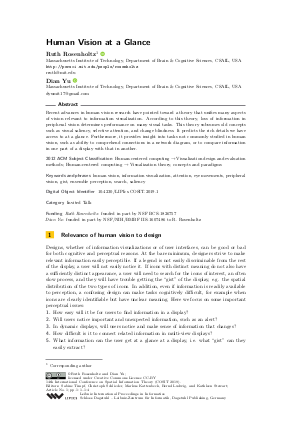Human Vision at a Glance (Invited Talk)
Authors
Ruth Rosenholtz  ,
Dian Yu
,
Dian Yu 
-
Part of:
Volume:
14th International Conference on Spatial Information Theory (COSIT 2019)
Part of: Series: Leibniz International Proceedings in Informatics (LIPIcs)
Part of: Conference: Conference on Spatial Information Theory (COSIT) - License:
 Creative Commons Attribution 3.0 Unported license
Creative Commons Attribution 3.0 Unported license
- Publication Date: 2019-09-03
File

PDF
LIPIcs.COSIT.2019.1.pdf
- Filesize: 285 kB
- 4 pages
Document Identifiers
Subject Classification
ACM Subject Classification
- Human-centered computing → Visualization design and evaluation methods
- Human-centered computing → Visualization theory, concepts and paradigms
Keywords
- human vision
- information visualization
- attention
- eye movements
- peripheral vision
- gist
- ensemble perception
- search
- saliency
Metrics
- Access Statistics
-
Total Accesses (updated on a weekly basis)
0Document
0Metadata
Abstract
Recent advances in human vision research have pointed toward a theory that unifies many aspects of vision relevant to information visualization. According to this theory, loss of information in peripheral vision determines performance on many visual tasks. This theory subsumes old concepts such as visual saliency, selective attention, and change blindness. It predicts the rich details we have access to at a glance. Furthermore, it provides insight into tasks not commonly studied in human vision, such as ability to comprehend connections in a network diagram, or to compare information in one part of a display with that in another.
Cite As Get BibTex
Ruth Rosenholtz and Dian Yu. Human Vision at a Glance (Invited Talk). In 14th International Conference on Spatial Information Theory (COSIT 2019). Leibniz International Proceedings in Informatics (LIPIcs), Volume 142, pp. 1:1-1:4, Schloss Dagstuhl – Leibniz-Zentrum für Informatik (2019)
https://doi.org/10.4230/LIPIcs.COSIT.2019.1
BibTex
@InProceedings{rosenholtz_et_al:LIPIcs.COSIT.2019.1,
author = {Rosenholtz, Ruth and Yu, Dian},
title = {{Human Vision at a Glance}},
booktitle = {14th International Conference on Spatial Information Theory (COSIT 2019)},
pages = {1:1--1:4},
series = {Leibniz International Proceedings in Informatics (LIPIcs)},
ISBN = {978-3-95977-115-3},
ISSN = {1868-8969},
year = {2019},
volume = {142},
editor = {Timpf, Sabine and Schlieder, Christoph and Kattenbeck, Markus and Ludwig, Bernd and Stewart, Kathleen},
publisher = {Schloss Dagstuhl -- Leibniz-Zentrum f{\"u}r Informatik},
address = {Dagstuhl, Germany},
URL = {https://drops.dagstuhl.de/entities/document/10.4230/LIPIcs.COSIT.2019.1},
URN = {urn:nbn:de:0030-drops-110937},
doi = {10.4230/LIPIcs.COSIT.2019.1},
annote = {Keywords: human vision, information visualization, attention, eye movements, peripheral vision, gist, ensemble perception, search, saliency}
}
Author Details
- Massachusetts Institute of Technology, Department of Brain & Cognitive Sciences, CSAIL, USA
Funding
- Rosenholtz, Ruth: funded in part by NSF BCS-1826757
- Yu, Dian: funded in part by NSF/NIH/BMBF IIS-1607486 to R. Rosenholtz
References
-
J. J. Andriessen and H. Bouma. Eccentric vision: Adverse interactions between line segments. Vision Research, 16(1):71-78, 1976.

-
B. J. Balas, L. Nakano, and R. Rosenholtz. A summary-statistic representation in peripheral vision explains visual crowding. Journal of Vision, 9(12):13, 2009.

-
H. Chang and R. Rosenholtz. Search performance is better predicted by tileability than by the presence of a unique basic feature. Journal of Vision, 16(10):13, 2016.

-
K. A. Ehinger and R. Rosenholtz. A general account of peripheral encoding also predicts scene perception performance. Journal of Vision, 16(2):13, 2016.

-
A. Hollingworth and J. M. Henderson. Accurate visual memory for previously attended objects in natural scenes. Journal of Experimental Psychology: Human Perception & Performance, 28(1):113-136, 2002.

- R. Houtkamp, H. Spekreijse, and P.R. Roelfsema. A gradual spread of attention. Perception & Psychophysics, 65(7):1136-1144, 2003. URL: https://doi.org/10.3758/BF03194840.
-
S. Keshvari and R. Rosenholtz. Pooling of continuous feature provides a unifying account of crowding. Journal of Vision, 16(3):39, 2016.

-
F. L. Kooi, A. Toet, S. P. Tripathy, and D. M. Levi. The effect of similarity and duration on spatial interaction in peripheral vision. Spatial Vision, 8(2):255-279, 1994.

-
R. A. Rensink, J. K. O'Regan, and J. J. Clark. To see or not to see: The need for attention to perceive changes in scenes. Psychological Science, 8:368-373, 1997.

- R. Rosenholtz. Capabilities and limitations of peripheral vision. Annual Review of Vision Science, 2(1):437-457, 2016. URL: https://doi.org/10.1146/annurev-vision-082114-035733.
- R. Rosenholtz, J. Huang, and K. A. Ehinger. Rethinking the role of top-down attention in vision: effects attributable to a lossy representation in peripheral vision. Frontiers in Psychology, 3:13, 2012. URL: https://doi.org/10.3389/fpsyg.2012.00013.
- R. Rosenholtz, J. Huang, A. Raj, B. Balas, and L. Ilie. A summary statistic representation in peripheral vision explains visual search. Journal of Vision, 12(14):1-17, 2012. URL: https://doi.org/10.1167/12.4.14.
- B. J. Scholl. Attenuated change blindness for exogenously attended items in a flicker paradigm. Visual Cognition, 7(1-3):377-396, 2000. URL: https://doi.org/10.1080/135062800394856.
-
M. Scolari, A. Kohnen, B. Barton, and E. Awh. Spatial attention, preview, and popout: Which factors influence critical spacing in crowded displays? Journal of Vision, 7(2):7, 2007.

-
M. E. Smith, L. Sharan, E. Park, L. C. Loschky, and R. Rosenholtz. Difficulty detecting changes in complex scenes depends in part upon the strengths and limitations of peripheral vision. Journal of Vision, under revision.

- B. W. Tatler, M. M. Hayhoe, M. F. Land, and D. H. Ballard. Eye guidance in natural vision: Reinterpreting salience. Journal of Vision, 11(5):5, 2011. URL: https://doi.org/10.1167/11.5.5.
-
A. Treisman. How the deployment of attention determines what we see. Visual Cognition, 14:411-443, 2006.

-
A. M. Treisman and G. Gelade. A feature-integration theory of attention. Cognitive Psychology, 12(1):97-136, 1980.

-
J. M. Wolfe, M. L.-H. Vo, K. K. Evans, and M. R. Greene. Visual search in scenes involves selective and non-selective pathways. Trends in Cognitive Sciences, 15(2):77-84, 2011.

-
X. Zhang, J. Huang, S. Yigit-Elliot, and R. Rosenholtz. Cube search, revisited. Journal of Vision, 15(3):9, 2015.

